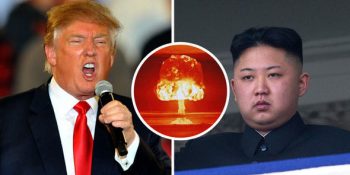State of International Relation with Kim Jong-un
SEOUL, South Korea (Associated Press) – Donald Trump’s threat to unleash “fire and fury” on North Korea might have been written by Pyongyang’s propaganda mavens, so perfectly does it fit the North’s cherished claim that it is a victim of American aggression.
Not since George W. Bush labeled North Korea part of an “axis of evil” has the nation had such a strong piece of presidential evidence to back up its argument that only nuclear and missile development can counter “hostile” U.S. policies aimed at ending the rule of the latest member of the Kim family of dictators.
Trump now runs several risks by matching his rhetoric to that of the North, which has regularly vowed to reduce archrival Seoul to a “sea of fire.”
Word choice matters on the Korean Peninsula. A torrent of belligerent warnings by the North in 2013, for instance, including nuclear strike threats against specific U.S. targets, led to an anxious, weeks-long standoff that saw the United States fly its most powerful warplanes _ nuclear capable B-2 and B-52 bombers, and F-22 stealth fighters _ near the North Korean border.
The risk, now as then, is that heated words could cause a miscalculation that might trigger real fighting across the most heavily armed border on earth, a border that’s only a short drive from greater Seoul’s 25 million people.
Trump’s comments Tuesday were actually linked to Pyongyang’s never-ending stream of threats: “North Korea had best not make any more threats to the United States,” Trump said. “They will be met with fire and fury like the world has never seen.”
Though it seems unlikely it was directly responding to those comments, the North on Wednesday repeated past warnings that it’s examining operational plans for attacking the U.S. territory of Guam.
This is mostly a bluff: North Korea is extremely unlikely to follow through on a suicidal pre-emptive attack on the United States. But there is also almost zero chance that the North will miss the opportunity to put its propaganda specialists to work topping Trump’s threat of total war. Pyongyang, after all, may be the world’s leading producer of such threats _ against Seoul, against Tokyo, against Washington, against essentially anything or anyone seen as hostile.
As John Delury, an Asia specialist at Seoul’s Yonsei University, tweeted following Trump’s comments, “Trying to out-threaten North Korea is like trying to out-pray the Pope.”
The risk is that what works for a tiny, impoverished dictatorship that has long seen itself as sandwiched between geopolitical behemoths whose only aim is using the Korean Peninsula for their own interests might not work for the world’s most powerful economy and military.
Trump now confronts a problem that North Korea has long faced: Over-the-top threats are one thing, but what do you do when you can’t back them up?
So far, of course, North Korea has favored smaller scale sneak attacks over following through with its threats to launch missiles into Seoul, let alone a U.S. territory. North Korea will surely continue its nuclear bluster, but Trump cannot bring “fire and fury” without risking the destruction of Seoul, and the deaths of tens of thousands of U.S. troops and citizens in South Korea.
Trump’s comments also feed North Korea’s craving for global attention.
The country uses its scary rhetoric and nuclear boasts to force itself to the top of outside governments’ foreign policy lists. For the North, being ignored is a worse fate than being criticized.
Trump’s “fire and fury” line might also hurt his efforts to get China, the North’s economic and diplomatic enabler, to do more to curb Pyongyang’s nuclear ambitions.
China, though it does not want a nuclear North Korea, sympathizes with Pyongyang’s claim that it is under real threat from Washington.
“The U.S. is trying to tell China, `We’re not in this for regime change; we’re not trying to take down (leader) Kim Jong Un; we’re not trying to reunify the Korean Peninsula; what we want is to negotiate their nukes away,’ Delury said in an interview. “To use unprecedented, inflammatory language, to threaten war on North Korea because they make threats, undermines the work the U.S. is trying to do to keep the Chinese on board.”
Before Trump’s threat, the North’s biggest recent example of so-called U.S. hostility was the joint military drills staged by allies Washington and Seoul. Those start up again in a few weeks. Expect to see “fire and fury” drive North Korean propaganda then, and for a long time to come.
By FOSTER KLUG
– Associated Press
CNN Reports Today: Trump “Maybe Fire & Fury” Is Not Tough Enough
HELP US SPREAD THE NEWS!
COMMENT, Like, Follow & SHARE to get your daily dose of Tips, Tricks, News and Events! @I70Scout
RELATED NEWS
WEATHER & TRAFFIC PUZZLES RECENT NEWS ADVERTISE WITH US

Leave a Reply